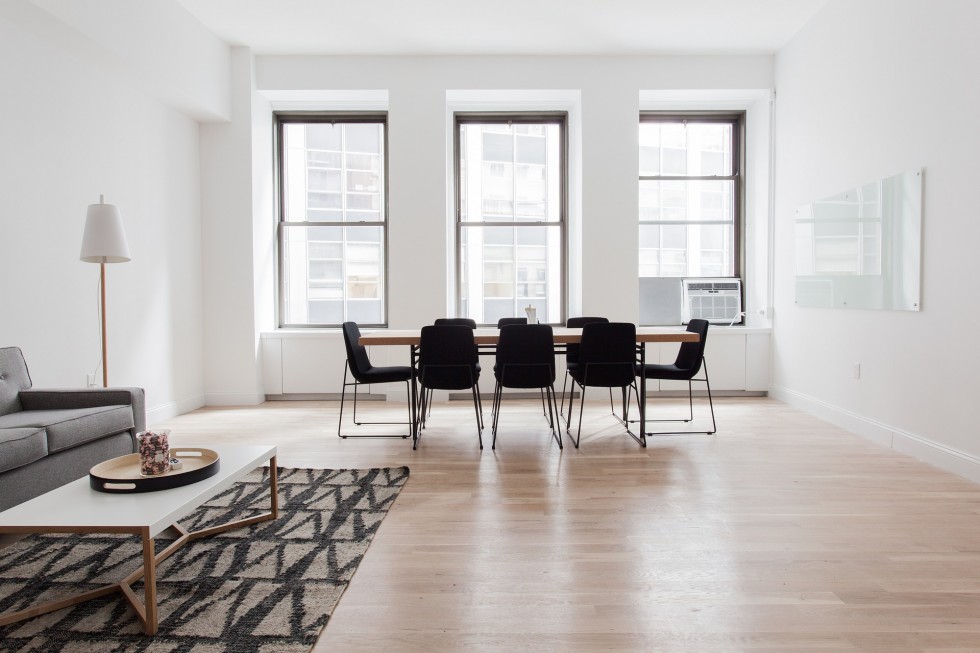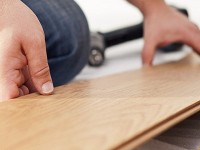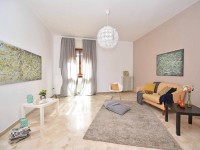Modern weatherproof windows, roof that never leaks, perfectly working chimney, good furniture: there are so many things that make a cozy and pleasant-to-live-in house. One of the important factors is also practical and attractive flooring. Whether you’ve just moved in or are thinking of breathing a new life into your old dwelling, you need to consider different flooring types. You can choose them depending on your budget, number and age of your family members, specific room, or your aesthetic preferences. Here are the most common options with their advantages and drawbacks.
1. Hardwood
This is one of the most well-liked flooring types among homeowners. Made of such kinds of wood as Oak, Pecan, Birch, Walnut, Maple, Beech, or Pine, this floor looks beautiful and feels comfortable to walk on. The best place for hardwood is a living room as you and your family members don’t walk there so often as, say, in the foyer.
Pros
- Can be sanded or refinished several times during its lifespan. You will probably need to get professional flooring contractors’ help to perform those operations. You will still save money, though, as you won’t need to have a new floor installed. It also adds value to your house if you decide to sell it later. This is a clear advantage of a hardwood floor over other flooring types.
- Wear resistant and durable.
- Easy to clean and maintain.
Cons
- High cost. The price range can be from $3 to $12 for a square foot. Don’t forget, though, that you will also have to pay for installation work.
- May darken over time.
- Susceptible to scratches, dents, and scrapes.
- Can be ruined by standing water. You also need to make sure humidity in your house is within the norm, as its high value can damage natural wood.
- Can be quite loud, but you can place a rug on the floor to muffle your steps.
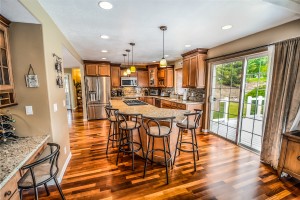
2. Ceramic tile
Ceramic tiles are made by mixing clay with minerals that are molded and kiln-baked. Several varieties of ceramic tile are available on the market such as quarry, porcelain, terra-cotta, and glazed ceramic. Thanks to its good water resistance, ceramic is the top choice among all other flooring types to be used in a bathroom and kitchen.
Pros
- Durable, well resistant to moisture and scratches.
- Easy to clean and maintain. Spill away as much as you want!
- No need to replace the whole floor if one tile gets incidentally broken, although you will probably need to pay a professional for that.
- Available in several finishes including textured, embossed, matte, and glazed.
Cons
- Grout lines are hard to clean.
- Cold to walk on, with specialized heating systems being quite expensive.
- Plates and cups break more easily in comparison with other flooring types.
- Loud to walk on.
- High-quality varieties are not cheap: up to $20 a square foot.
- Hard and time-consuming to install.
- Inferior quality tiles may chip.
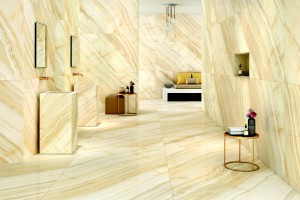
3. Laminate
This material is made of hard fiberboard as the base. On top of it, an image of something like wood or stone is placed, which is then covered by a transparent protective layer. This arrangement provides almost limitless patterns and textures. The durability of laminate makes it the top pick for rooms with heavy traffic, such as a foyer.
Pros
- Long-lasting and strong.
- True-to-life: laminate looks almost identical to most natural materials.
- Resistant to burns, chips, or scratches. Thanks to this characteristic, laminate flooring is good for families with dogs/cats and kids.
- Comes in a whole range of colors and designs.
- Easy to install. By using the snap together mounting method, homeowners can arrange the laminate boards on the floor with no help from outside.
- Relatively low cost. The cheapest laminate may cost as little as half a dollar, while the highest variety is typically around $3 for a square foot.
- Easy to clean and maintain similar to hardwood flooring.
Cons
- Impossible to refinish. When the outer surface wears out, you will have to replace the whole floor.
- Can be ruined by standing water. So, we highly discourage you from putting it in your bathroom, laundry, or kitchen where water is abundant.
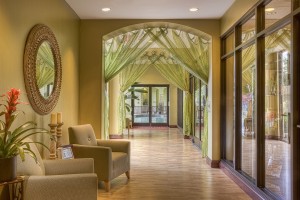
4. Linoleum
When pigments, cork/wood powder, resins, and some other substances are mixed with linseed oil and then pressed onto a jute backing, you get linoleum. Patterns and colors available for this material are probably the most varied among all flooring types. Depending on the quality and thickness, linoleum can be as expensive as $10 a square foot and above.
Pros
- Large variety of colors and designs.
- Rarely fades as a pattern takes up the entire linoleum area.
- Not susceptible to sunlight.
- Quite affordable and easy to put on the floor.
Cons
- Much less resistant to wear, tear, scratches, burns, and dents (for example, from furniture) than other flooring types.
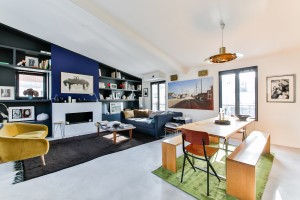
5. Carpet
This will help you stay on better terms with your neighbors downstairs if you live in an apartment: carpet flooring will muffle many noises that your kids or pets produce. The best place for this type of floor is a bedroom or living room with little walking activity.
Pros
- Soft, warm, pleasant to one’s feet.
- Available in many colors and designs.
- Comparatively affordable: from 2 to 5 dollars per square foot on the average.
- Simple to install.
Cons
- High maintenance. You will need to have your carpet cleaned professionally at least once a year. Vacuuming a carpet may not remove the dirt underneath it, which then finds its way into your respiratory system.
- Susceptible to stains, burns, and tears, although newer varieties are much stronger and clean better.
- Can be harmful to people suffering from allergies.

6. Cork
This belongs to natural flooring types and is made of the bark of the cork tree. A bedroom is a perfect place for having a cork floor since it muffles sounds and creates a cozy atmosphere. It’s also good for areas where kids play. The price of cork ranges from $2 to $8 per square foot.
Pros
- Natural, environmentally friendly material.
- Sound-reducing.
- Heat-retaining.
- Absorbs shock from long standing.
- Has excellent anti-mold and antimicrobial properties.
Cons
- Prone to fading when constantly exposed to direct sunlight.
- Not suitable for being used under furniture with pressure points.
- Swells when water stands on it for some time.
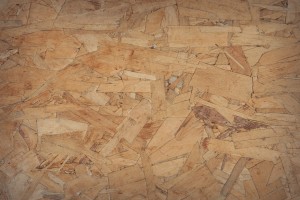
Choosing the right type of floor for your home is very important if you wish to create comfort in your rooms and make them look pleasing to the eye.
